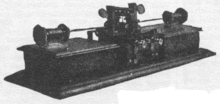Beat receptor

The beat receiver or beat receptor is a direct-conversion heterodyne detector designed by inventor Nikola Tesla prior to 1896 to receive continuous un-modulated radio waves (CW) and produce an audible note through the mixing of locally generated radio-frequency currents with radio-frequency currents from an antenna or receiving structure. This is achieved by the application of a locally generated radio-frequency magnetic field to radio-frequency currents flowing in a conductor.[1]
The beat receiver consists of an LC circuit made up of a capacitor plus a steel wire or band that is stretched through the field of a powerful electro-magnet. The capacitor is of comparatively large value because the conductor is short. The tuned circuit is excited by radio-frequency alternating current magneto-inductively coupled from the receiver's antenna.
The electromagnet is excited by stable radio-frequency alternating current produced by a local isochronous electro-mechanical oscillator known as a beat frequency oscillator or BFO.[2] It consists of two chambers in the center of which is placed a vibrating membrane. This is inclosed in a magnetic field, consisting of a powerful coil encircling the device, and which is excited by a direct current. The membrane is caused to vibrate by passing interrupted, compressed air through the two chambers. In the process of vibration, an electromagnetic force is produced in a coil secured to the vibrating disc.
The frequency of the locally produced oscillation is set close to the frequency of the received signal. The steel wire, brought under tension and mechanically tuned, is caused to vibrate at the resulting audible beat frequency of the local and received oscillations.
- "The apparatus is timed by adjusting the periodicity of the band until the received wave is made audible."[3]
The pioneering work of Tesla and Fessenden led to the development of basic intermediate frequency circuitry.[4]
See also
- Heterodyne
- Heterodyne detection
- Direct-conversion receiver – heterodyne conversion of a signal directly to baseband instead of to an intermediate frequency
- Intermediate frequency
- Beat (acoustics)
- Homodyne
- Superheterodyne receiver
- Transverter
- Intermodulation – a problem with strong higher-order terms produced in some non-linear mixers
References
- ↑ Cooper, Drury W., internal document of the law firm Kerr, Page & Cooper, New York City, 1916. (In Nikola Tesla on His Work With Alternating Currents and Their Application to Wireless Telegraphy, Telephony, and Transmission of Power, Leland I. Anderson, editor, Sun Publishing Company, 1992, pp. 25–29.
- ↑ Tesla, Nikola, The Inventions, Researches and Writings of Nikola Tesla, Thomas Commerford Martin, editor, "Mechanical and Electrical Oscillators," August 25, 1893, lecture before a meeting of the International Electrical Congress at the Columbian Exposition in Chicago.
- ↑ Cohen, Samuel D., "Dr. Nikola Tesla and His Achievements," The Electrical Experimenter, Feb. 1917. "The First "Beat" Receptor for Radio-Telegraphy Invented by Tesla, Which Foreshadowed the "Heterodyne.""
- ↑ Discussion of A History of Some Foundations of Modern Radio-Electronic Technology, Comments by Lloyd Espenschied, Proceedings of the IRE, July 1959 (Vol. 47, No. 7), pp. 1254, 1256. Critique. ". . . the roots of our modern technology trace back generally to sources other than the Hammond Laboratory." . . . Tesla and Fessenden leading to the development of basic intermediate frequency circuitry . . .